QBARS - v14n4 Five Letters From James Barto to Joseph Gable
Five Letters From James Barto to Joseph Gable
Dr. Phetteplace in his article "The Life and Work of James Barto" concluded in the Jury Bulletin of the Society, hoped that perhaps his article would uncover some letters written by Barto to further add to what even to this day remains the very scantiest of knowledge as to the list and origin of the Barto plants. James Barto's work even at this date borders closely on the legendary, and though it was often reported that he carried on a prodigious correspondence, the simple fact remained that only two pieces of such correspondence were known to exist. One, a letter to Mrs. Craddock, and one postal card to Mr. George Grace. "Were it only possible to bring to light some of his correspondence. "I wrote Dr. Phetteplace in early May," though at the same time I also surmised that I doubted that any such existed at this late date. That very week I received from Dr. Phetteplace a nostalgic letter from the now almost blind Joseph Gable and included were three letters written by Barto in 1930. Gable mentioned the possible existence of other letters in his files, and on July 20 two more Barto letters were sent to Dr. Phetteplace along with the long list of plants Barto was growing in 1932. The following two letters by Joseph Gable and the five Barto letters with the listing of plants may throw a new light on the thousands of Barto species and hybrids now growing on the Pacific Coast.
The five letters though most interesting may at times seem vague, since they allude directly to previous correspondence with Gable. For a complete picture Gable's letters of reply would also have to be presented. The letters are presented in their entirety with the exception of one sentence that was started and left unfinished by Barto. Other than that they are presented as they were written thirty years ago.
All the Barto letters were written in longhand and show fine penmanship. Every inch of paper was utilized. On the outside flap of an envelope mailed February 1932 appeared the following: "Could you give me Frasers address in British Columbia."
- Editor
May 9, 1960
DEAR DR. PHETTEPLACE:
I have read with great interest your article in the Society Bulletin on Mr. James Barto and it takes me back to the beginning of things here too. I can only find three of his letters in my files but I recall many of our exchanges of seeds and plants.
I think our first correspondence started with mutual acquaintance with Mr. George Fraser of Ucluelet, B.C. and through Mr. Fraser I started a correspondence with Mr. E. J. P. Magor of Cornwall, England and received both seeds and pollen which I shared with Mr. Barto. Then I also grew many seedlings from Mr. Magor's seeds and from Dr. Rock's collection which I knew would be tender here and I recall sending him several boxes of these by express. He, as you record wrote profusely and I was unable to keep up with him in that line.
The photo in the Bulletin of R. rex brings back memories. This was a Rock No. and I feel sure I have more data on it somewhere but I kept several plants of it under protection for years but never flowered it while he kept mentioning it as a beautiful plant and how well it was growing for him. Another that we wrote about was the Rock No. 03789-84054-18139 vernicosum aff. from the 1929 expedition, because of the very lovely bronze colored new growth on some seedlings. This, by the way, has proven hardy here and we have some lovely apricot pink hybrids showing their first flowers at the moment. If they live up to their first showing they will take their place among the superlative that are hardy here. The plant habit and foliage being also excellent. I have never heard of the flowering of this number in any other growers list?
There should be a list here of all the Rock numbers I sent to Mr. Barto and also of those he sent for he divided some of Rock's seeds with me that he had from Mr. Brower, but if his records were all burned these would be of no value to you.
My vision has deteriorated to the point that I can only poorly decipher these letters I send and it is difficult for me to find things in my files. There may be more Barto letters taken from the files and piled into boxes or they may have been discarded in some house cleaning operation. I do not know.
From your article telling the difficulties under which he started we must have had considerable in common. I too recall of referring him to F. M. Ellis as a source of Davidia seeds. The first lot we got were both good but the second time, when I at least, invested much heavier, they all proved to be 'duds'.
Still the old hard days were the good days!
Sincerely
Joe Gable
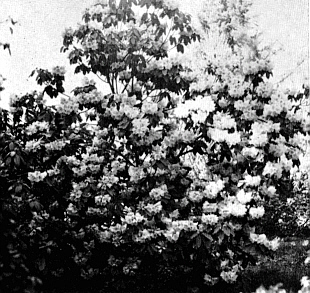
|
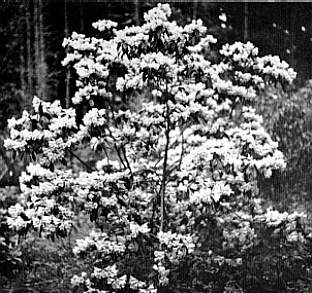
|
|
Fig. 39.
R. fargesii
from the Barto Garden
growing in the Society Test Garden, Crystal Springs Island C. Smith photo |
Fig. 41.
R. rubiginosum
, one of the fine
Barto plants C. Smith photo |
July 20, 1960
DEAR DR. PHETTEPLACE:
We have found some more "Bartoniania" and am sending it on to you. I had a very difficult time trying to read it over with my old eyes - or rather eye and so I send it along to you.
I wish it could be printed and wonder if the Bulletin could be persuaded to do this? It would be interesting to many members.
This has interested me in taking some backward glances too. Mr. Barto, George Fraser of Ucluelet, Vancouver Island, B.C., and Halfdan Lem then of Ketchikan, Alaska, and Endre Ostbo were my first correspondents in the Northwest and we did a world of trading seeds and tiny seedlings. Through Mr. Fraser I became acquainted with Mr. E. J. P. Magor of Cornwall and he sent me pollen and seeds of hundreds of species and varieties. Many of these I deemed would be useless to try here and sent them west, and they sent me many things too.
Somewhere between 90 and 100% of these were too tender here but I made use of those I could keep and sent those that killed back out where I hoped they would have a better chance to become good U.S. citizens. I think all of Mr. Barto's Rock Numbers came from seeds that came to me from Glenndale and from The Arnold Arboretum in Prof. Sargent's day - (he died in 1926 or 27?) - from Dr. Bowers and from Anton Brower on Long Island. I did not go over my whole list for they are almost if not quite-as interminable as Mr. Bartos, though my notes are much shorter on most items as they were tender and promptly disposed of themselves in our climate. But there are some numbers on the collectors lists are doing well here. One in particular is Rock's No. 18139, Vern. aff. Pink. (Edinburgh) which has beautiful apricot or peach pink flowers of the fortunei type and quite hardy here.
Hoping these letters will be of some use to you. I am,
With sincere regards,
Jos. B. Gable
I presume that you will keep these letters? Or turn them over to the American Rhododendron Society? If you print any copies of them I would appreciate one for I can read printed or typewritten material fairly well.
LETTER NO. 1
Junction City, Oregon
March 20, 1930
Mr. J. B. Gable
Stewartstown, Pa.
DEAR SIR:
The secretary of The Rhododendron Association has sent me under my permit No. 1868 a box of rhododendron seed.
Mr. Gurney Wilson, secretary gave me your address and requested me to let you have some seed if I would. I divided the varieties that had enough seed to make fairly sure of getting plants for all. Of course, there is one more address: Mr. Ancel Brower, Hickory Hill Nursery, Newport, Long Island. I am giving the address so if your seed fails or mine we might have plants from the above.
I have seedlings of many varieties one three years old and still am adding as fast as possible, also some hybrids. Growing the Davidia involucrata (Dove Tree) that I received from Wilson and bulbs and rare plants that can be raised from seed and cuttings.
Respectfully yours,
J. E. Barto
LETTER NO. 2
Junction City, Oregon
March 27, 1930
Mr. J. B. Gable
Stewartstown, Pa.
DEAR SIR:
I missed one packet of seed in same to you and Mr. Brower. I enclose it to you. If you have a packet of this species* please forward the seed to Mr. Brower, Hickory Hill Nursery, Newport, Long Island.
Respectfully,
J. E. Barto
* The species was R. williamsianum for written across the top of the letter in Mr. Gables handwriting was "This must be williamsianum".-EDITOR
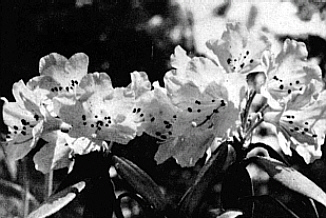
|
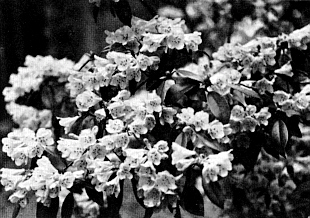
|
|
Fig. 40 A clonal form of
R. desquamatum , R. 'Finch' R. Henny photo |
Fig. 42
R. rubiginosum
C. Smith photo |
LETTER NO. 3
Junction City, Oregon
April 10. 1930
Mr. Joseph B. Gable
Stewartstown, Pa.
DEAR SIR:
I thank you for the list and will be pleased to exchange with you. I expect to have seedlings of about 300 varieties and species of rhododendrons and azaleas this fall. Perhaps we can supply each other with plants missing in our collection. Of the rhododendron you wish I have R. chrysanthum 20 plants 1 year and also germinated seed of R. haematodes , R. campylocarpum , R. lacteum , R. dichroanthum & R. williamsianum .
R. chrysanthum is from Kew. Some from The Arnold Arboretum, Royal Botanical Garden also seeds from members of the Society.
The J. F. Rock R. carolinianum interests me very much. Perhaps you might have one to spare this fall with bloom buds on. My interest is in getting the strain for hybridizing that I hope to give a great deal of attention.
Our climate is great for the Erica family and I hope to take full advantage of it. Will make out a full list of species and so forth this fall that I have so we can compare lists.
Respectfully yours,
J. E. Barto
LETTER NO. 4
Junction City, Oregon
February 2, 1932
Joseph B. Gable
Stewartstown, Pa.
DEAR SIR:
I guess I am not much of a correspondent, conditions are somewhat to blame. The most unusual year here, plants grew fine at that. Rains stopped June 1, and ¼ inch fell until the rains started in November. This was a long and exceedingly dry spell. Terrific rain followed one week of black cold-6 F., and heavy winds most of the time. This sure cut the tender species, those surviving are worth a great deal for propagation. Most of the Rock numbers are alright so far even unprotected. Most surprising is R 04007 heliolepis even only 1 year and this seedling is looking extra good.
Before I forget please set aside 2 falconers series Rock 18234 for me as I am afraid my few plants are gone.
After things clear up I will check your want list and see how my plants are. At one time 4 feet of snow covered the ground, now rain, snow and repeat week on week. I do not know when it will let up. Usually the last of February is good. R. dauricum , mucronulatum for all this weather are about to open. A R. yunnanense flowered last October for the first time with a good set of buds remaining for spring flowering.
After studying the problems mentioned before, another observation; on Mt. Hood I lifted several small rhododendron in September, and in that location or in cultivation no plant could be alive in such a dry situation. On the western edge of the fir forest and some 50 to 100 feet inside the trees had entirely sapped the ground of moisture. This ground was covered with 12 inches of un-decomposed leaf litter almost packed as hard as clay. This spot receives as much as 12 feet of snow and seldom less than 6 feet. Then the rains wet the snow here the buildings are destroyed since they cannot withstand the weight. This refers only to an elevation of 3000 feet and up. In this litter I noticed a dry salt which helps my theory of salt or that aluminum sulphate should be added to plants. Other lifted plants flowered last year also. I lifted them where road crews cut them to the ground. One of these was a clear pure pink, another was petaloid with recurved petals. I wonder if this could produce a double as R. 'Fastuosum Flore Plenum' the catawbiense hybrid. Hope to get some grafted off the 5 bud branch. The larger shrub in nature when I lifted it had three flower buds for each of seasonal growth the year before.
Where ignorance is bliss it is folly to be wise they say. But my ignorance saved me from the mistakes made last year and former years. My first seedlings were raised in a compost of rotten wood, sharp sand and very old decomposed litter dug out of the base of rotten centered maples. Into this was mixed more or less with a buck-shot soil that had been washed by rain into the hollow cavities on my hills. This is a very arduous job if much material is to be gathered. This mixture had its quota of weeds and required a lot of work. But all this work I attribute to the successful propagation of rhododendron here. As you know seed must be kept close, and in extreme hot weather the newspaper I used had to be kept moist by light sprinkling. This settled the paper so close to the seeds that moss would start when I used it for the beds later, and used peat moss. But my native mixture did not do this until seedlings were large enough to ex; hide the air. Once or twice a day weeds would gently force the paper from the compose surface airing the germinating seed, and allowing larger amounts of water to be soaked into the porous paper. This made a balance between air moisture and the dry litter.
I have grown 'Amurisaku' and poukhanense 4 inches in one season from seed. On fortunei there were seven distinct breaks of growth in one season. All species cannot be induced to do this, yet, before a High School class R. fortunei made 24 inches of growth at the end of a second season. The plants were less than ½ inch in height when they were planted.
The use of tweezers to pull weeds is best. Take hold at ground level, this prevents breaking of the weeds and removing their roots and at the same time not moving the compost.
Due to losses in bank failures and lack of business it is hard to keep up with expenses. I may not be able to supply all of your want list as the outcome of last winter cannot be assessed. The surviving plants should be hardy elsewhere, or with just a little protection, as they are growing here unprotected.
You may be sure if you follow Wilson cultural ideas for producing hardiness, means terrible losses, sometimes 1 oz. of seed only produces a very few plants from a tender species. However in the long run, I will not be disappointed after years of labor if a species proves unsatisfactory.
I would like financially to aid the forming of a U. S. Rhododendron Association, but cannot do so now. Yes. the slopes of five pass caravan route in Kashmere look good to me. The highest range 18,500 feet may yield something hardier for the U.S. I would very much like to aid in the exploring of this region. betula and evergreens cover the slopes as nearly as I can find out.
I wonder if in the trade of plants I furnish you enough to repay plants from you. As it is now I could do no other way.
I have never visited your section of Pennsylvania, not having gotten so far south, but can judge conditions fairly well. My boyhood was spent near Williamsport, then Philadelphia, Pittsburg and Annapolis. I visited many cities when I was with the navy.
Enclosed is a leaf of a very hardy R. racemosum with a white edge of underside showing. In not so severe winters a lovely foliage form. I wonder if you have this. Hope to have rooted cuttings of this this coming fall. A few R. 'Loderi' are hardy, some lost a seasons growth. Other with hardy branch buds seem O.K. This and some R. falconeri , R. lacteum and others a lapponicum with lavender flowers in late July were lost. They were from Rock 1929.
I would like 2 plants each in trade for plants I have R. aechmophyllum, adenogynum, agastum carolinianum album, detonsum, falconeri series Rock 18234, floccigerum, intricatum racemosum 19404 Forrest and traillianum. </p>
</i> I am enclosing a packet of seed of Rh. californicum which I gathered on Mt. Hood near Government Camp about 4000 ft. It should be hardy if wood is ripened before freezing. Thanks for the calendar. It is good.
Are you in on the Rock 1932 expedition. I could not make it, not enough business.
Rh. oldhamii 1 year cuttings did not lose their leaves so far. The older plants did but appear to be alive. This species is sometimes deciduous and should not be as tender as rated but is well worth all the care since it is such a lovely thing.
A large rose double flowered Indica x oldhamii looks as it will be as good a doer as oldhamii which will be good. Rh. occidentals x 'Loderi' and other crosses are interesting and a large magnifying glass discloses a great difference of leaves. Rh. californicum x thomsonii has glands above and below a red undersurface. The Rh. californicum was a good pink 3½ inch flowers, with crepe like petals of good pink flowers. They were 21-27 to a truss.
Respectfully yours,
J. E. Barto
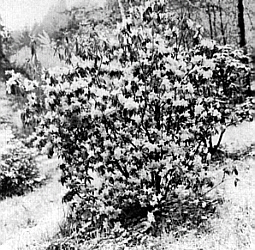
|
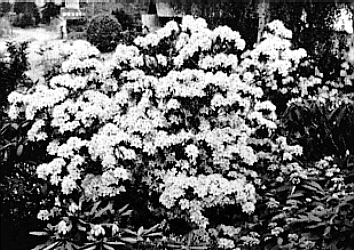
|
|
Fig. 43 R. 'Barto Blue'
A hardier form of R. augustinii. Phettplace photo |
Fig. 44
R. yunnanense
from Barto
Phetteplace photo |
LETTER NO. 5
Junction City, Oregon
July 8, 1932
Mr. Joseph B. Gable
Stewartstown, Pa.
DEAR SIR:
I thank you for your list, however, I am afraid it was destroyed in some manner as it is nowhere to be found. The list enclosed is of species and hybrids I have in numbers from one to a thousand or more. R. racemosum oleofolium in flower only two years from seed. Oldhamii in four years, japonicum only four years to flower and lovely now. Also some American azaleas and imported hybrids in flower at this date along with R. maximum .
R. maximum does not do well as a rule on the Pacific coast is the information I can get, yet it is a good grower with me. No species or series compares to R. fortunei and its s.s. One species Wilson sent me seed of is a good variety, supposed to be a deep red and it is a wonder. Now 18" to 30" in only two years. Plant leaves 8" long and throwing side shoots. Several of these I disbudded to induce branching, but think that will be no advantage. R. 'Beauty of Tremaugh' is another extra good one 16" to 24" in 2 years. R. fortunei x thomsonii will make 12" to 18" 2 year R. davidsonianum makes 12" in a year. R. arboreum seem 18" to 36" in 4 years also seems a good one and apparently hardy here. The triflorums are inclined to grow too late and are therefore sometimes with blackened tips. I believe this is my fault by forcing growth too late.
It is developing my trade as a carpenter took me to the outposts of settlement. The coast and high mountain areas. While at Waldport on the coast moving a house I heard of a pure white rhododendron, and next season discovered this plant. Only one man knew of it and he was dead for several years. According to Wilson it is the missing species reported by Menzies over 150 years ago. Also in Alsea Bay the salt spray carried overhead and falling as rain tasted brackish. Rhododendrons lived in it all around. Every house here had its boat tied to the porch in preparedness for the ever expected tidal wave which inundated this town periodically. All this site is a wonderful rhododendron area. Therefore salt is a good thing for Rhododendron californicum and also I believe for every rhododendron in existence. A close study here show rhododendrons in nature grow only on westerly slopes, facing the Pacific even if only a few yards from the edge of a bluff, along the ocean front or even two hundred miles inland. Our winds and rain from the ocean carry salt high in the air in a liquid state from the storm centers at sea. The leaf mould here has not broken down, but is forming a peat colored mulch of many years harvest, and sometimes 12" deep on the west slopes and on east slopes only one third that this is a wonderful study to me and proving itself by the response of rhododendrons that I am growing. The foliage color is all it could be and more. It is good to see growers almost gasp when entering my lath houses. I do not think the application of salt is good in the plant growing season, but in winter when nature in her moods and gales does it it cannot be wrong. I was born upstate from you and as you know a good Dutchman would not put in an asparagus bed without 2" of salt 18" below the surface of the ground. My theory is that salt adds to an acid soil and should aid as lime does to an acid soil. The doctors of science here at the Dept. of Agriculture wonder if other methods of culture should not be tried, since my plants show so well.
The hardiness of plants in the English yearbook does not hold good here. Some hardy so called showed the freeze. R. maximum in Portland for one was even badly hurt. This brings us down to position, exposure and hardening, where individuality of. the plant in the series may be taken into consideration. Ripe, hardened wood must be there regardless. The lapponicums are rather exacting in this respect. The grande, falconeri lacteum, supposed to be tender are hardy if ripened. I had a lot of unnamed varieties of seed sent to me by Wilson and by using his ideas they were left out all winter. The first year showed a loss of 75%, however I will have no fear of the remaining plants since the tender ones have been weeded out by nature. When I received the names a year later you may imagine my surprise. This was a lesson not to be lightly taken or easily forgotten. I will profit by it in the future.
I do not know if it is customary for species to break or make more than one growth. Some have broken seven times in a single season. R. 'Pink Pearl' made 24" in 2 years from cuttings, breaking time after time with over 18 branches. It may be the salt and aluminum sulphate in conjunction with ripening of the wood by withholding water that is doing it. Of course, I spray them on the foliage as orchids are done, and there almost seems to be a link with orchids in this spraying the foliage.
If you have another copy of the list I would appreciate another one. I am much interested in hybrids, our own crosses. R. occidentale is a swamp azalea in some places here, and is growing in running water 7 or 8 months of the year. I do not think the roots would stand deep freezing.
J. E. Barto
